
scrounge: /skrounj/ informal verb: to actively seek [books] from any available source
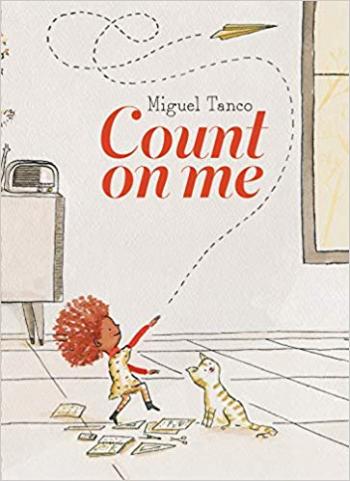
The unnamed girl in Count on Me begins by telling us that everyone has a passion. She shows some of her family members' passions, as well as some of the things she tried that just weren't for her. Then she reveals what her passion is: math. She enjoys looking for it in the world around her, in the form of geometric playground equipment, concentric circles in the water, etc. While this section of the book doesn't go into a lot of detail about mathematical concepts, it serves to present math as a way of seeing the world, as well as to normalize it as something for a girl to do.
At the end of the book, there are several pages describing in more detail how to look for different kinds of math in the real world: fractals, projections, polygons, etc. This section was helpful and gives a more tangible picture of how ubiquitous math is when you know how to look for it. (Despite the title, counting isn't really discussed here.) We enjoyed this book very much, and the watercolor art is beautiful.
(In compliance with FTC guidelines, I disclose that I received this book for free through LibraryThing Early Reviewers. I was not required to write a positive review.)
Scrounged From: LibraryThing
Format: Hardcover
Author/Illustrator: Miguel Tanco
Pages: 48
Content Advisory: None
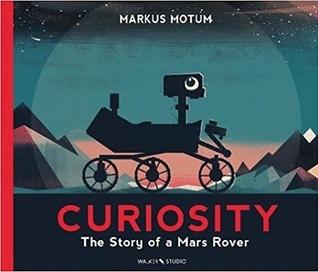
Curiosity: The Story of a Mars Rover is a great book for kids who are curious about outer space and astronomy, robots, or science and technology in general. While it conveys a lot of information and has more pages than many picture books, most pages aren't very wordy and so it might also appeal to some pre-kindergarten-aged children too.
The story is told from the perspective of Curiosity itself, and that plus the eye in the cover picture made me a bit wary, because it can be easy for the personification of non-human characters to distract from the story or veer into absurdity. But I think it works here. Curiosity's story is still told in a straightforward, nonfictional manner -- the personification wasn't done for entertainment value but instead to help keep the narrative relatable and focused.
This book is about Curiosity, but it's largely about science in general -- about questions and answers and why we send all these robots into space to begin with. I like how the grander desire for exploration is expressed so clearly throughout the story of the robot, making the scope much larger than just one robot or planet.
Of course, the robot's story is primary, from the whys and hows of development, to interesting details and complications involved in the launch, to the tension of the final moments of Curiosity's arrival on Mars that was witnessed by people around the globe. And all this still manages to stay within the realm of understanding of a young elementary-aged child.
I thought this book was really well done, and would make a great gift or science resource for elementary-aged children.
Scrounged From: Amazon
Format: Hardcover
Author/Illustrator: Markus Motum
Pages: 56
Content Advisory: None
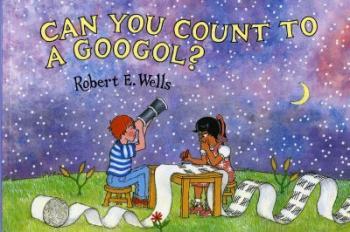
A while ago, in this post, I wrote about some titles in Robert E. Wells' science series that we've really enjoyed. We've since read a few more books from this series that we've enjoyed just as much, so I decided we needed a "part two."
The first is Can You Count to a Googol?, which uses creative illustrations and simple mathematical concepts to introduce students to progressively larger numbers -- from one, to ten, to one hundred (with the reminder that each zero at the end makes a number ten times bigger), to even more. The visualizations include baskets full of marshmallows, penguins eating many scoops of ice cream, and dollar bills packed onto pallets. The end blew our minds a bit as we tried to understand just how big a googol is (one with one hundred zeroes after it). Even then, the reminder that numbers never end gives a lot of perspective as we contemplate outer space and other things so much bigger than us. This book is similar to How Much Is a Million?, a memorable Reading Rainbow book, but I appreciate that this one walks us through even larger numbers and is more clear about how to get from one to another.
The next is Did a Dinosaur Drink This Water?, which is a very thorough exploration of the water system (dinosaur-loving kids may be disappointed to find out that this isn't really about dinosaurs, but it does emphasize how water molecules have been recycled over and over for a very long time). Since it mentions water molecules, this might be an interesting follow-up to What's Smaller Than a Pygmy Shrew? It covers fresh vs. salt water, how water is naturally cleaned and filtered, evaporation and rain, hydroelectricity, and also a bit about conservation at the end, which actually follows well from the text and doesn't feel "tacked on" like these things sometimes do.
Lastly, we've also enjoyed How Do You Know What Time It Is?, which is one of the more thorough titles we've read since it covers aspects of both science and history, and it may be harder for younger children to follow. But it does a great job introducting children to the concept of time, and how we don't even really know what it is. The history comes in when it discusses many of the earlier methods that people used to measure time, such as sun dials, water clocks, and solar vs. lunar calendars. From there it goes into earth's rotation and orbit, as well as time zones and other complications of measuring time. I appreciated the science and history, but also the straightforwardness about mystery, and how much science still hasn't been able to tell us about many concepts, such as time.
Scrounged From: Our local library and AbeBooks.com
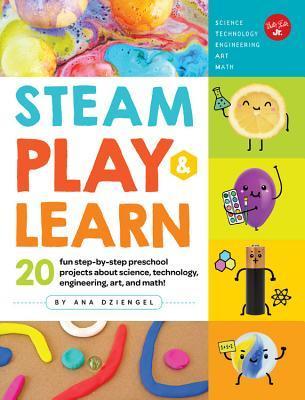
With vibrant photos and cute, colorful illustrations STEAM Play & Learn provides a bunch of fun activities for preschool or early-elementary-age children. Whether it's making a colorful volcano out of a lemon, a battery out of a lime, or giant building blocks from lunch bags and crumpled newspaper, this book includes activities that encourage problem-solving and engineering, but many also involve creative and artistic elements too.
The activities are grouped based on difficulty: easy, medium, and difficult. Some involve a lot of adult prep including hot-gluing and using tools (though the "Newton's Cradle" out of popsicle sticks does seem pretty cool!), but fortunately most fall into the "easy" category, and some can even be done with common household items. Food coloring is a common ingredient, as well as marbles, clay, baking soda, etc.
I've already gathered some inspiration on making building materials out of cardboard tubes with holes punched in them and straws (though we used pipe cleaners instead), and the "goop" recipe looks like it will be a fun thing to do outside in the summer.
It looks like there will be something here for everyone with young kids, whether you just want something quick and easy for preschoolers, or feel like tackling a multi-step activity for older kids, and each one includes some information about the particular scientific principles that are at work, plus each one looks like it would be a lot of fun.
(Thanks to NetGalley for the review copy.)
Scrounged From: NetGalley
Format: Kindle
Author: Ana Dziengel
Pages: 80
Content Advisory: None
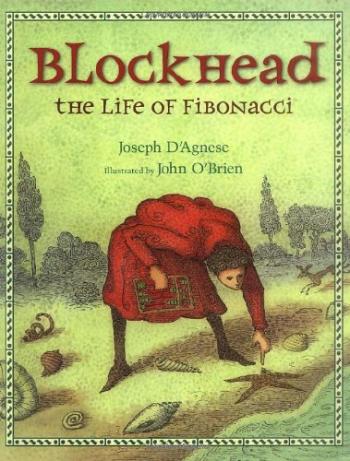
I'll be honest, words tend to hold much more interest for me than numbers. But that means that if I'm going to learn about a new mathematical concept, a picture book like Blockhead: The Life of Fibonacci is probably the best way to do so.
The author, Joseph D'Agnese, admits in the informational page at the end that very little is actually known of Fibonacci's life. So some aspects of this story are speculation, but we are told the basics: that Leonardo Fibonacci was born in Italy in the 1170s and became one of the greatest known Western mathematicians of the Middle Ages.
This book is written from a first-person perspective, and the title is taken from Fibonacci's nickname, "Bigollo," which could mean "traveler," but could also mean "idler, dreamer, or lazy person." In this story, Fibonacci's obsession with numbers leads to him being labeled as a "blockhead" by some, which of course is not true.
As we learn (through dialog with Fibonacci's friend, Alfredo), Fibonacci not only popularized the Hindu-Arabic numeral system that we use today, but he also noticed numerical patterns in the world around him that came up over and over again. This book includes an explanation of his "rabbit problem," (leading to the Fibonacci sequence) and a visualization of the golden ratio spiral. The illustrations include several other examples of the fibonacci sequence in nature, which readers are invited to go back and search for on the last page.
While the book does not really delve into the implications of these numbers, it still gave me a visually engaging way to learn about them, as well as an appreciation for Fibonacci's curiosity, and the incredible complexity of nature. As Fibonacci tells us at the end, "Now you see why I don't mind being called Blockhead, after all!"
Scrounged From: Amazon
Format: Hardcover
Author: Joseph D'Agnese
Illustrator: John O'Brien
Pages: 40
Content Advisory: None (though some may object to use of the phrase "mother nature")

